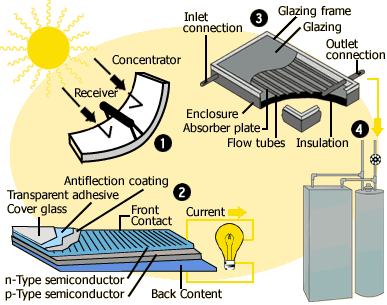|
|
|

|
(1) Concentrating Solar Power System Concentrating solar power plants produce electric power by converting the sun's energy into high-temperature heat using mirror configurations. The sunlight is concentrated by parabolically curved mirrors onto a receiver pipe that runs along the inside of the curved surface. The sun's reflected energy heats oil flowing through the pipe and the heat energy is then used to generate electricity in a conventional generator. A collector field comprises many troughs in parallel rows aligned on a north-south axis to track the sun from east to west during the day. Individual trough systems currently can generate about 80 megawatts of electricity. Some systems use thermal storage during cloudy periods or at night to continue electricity production. (2) Solar Cell System (Photovoltaic) Photovoltaic cells convert sunlight directly into electricity. When energy from the sun comes in contact with the cell, electrons in the two different semiconductors absorb the energy and use it to move around, creating an electrical current. Photovoltaic cells that are linked together to create a useful energy flow are called modules, which hold about 40 cells. About 10 of these modules can be mounted together to form a large array. Arrays can be used to generate electricity for a single building or, in large numbers, for a power plant. |
|
(3) Collector The energy emitted from the sun is used to heat water. Solar water heating systems for buildings have two main parts: a solar collector and a storage tank. Typically, a flat-plate collector - a thin, flat, rectangular box with a transparent cover - is mounted on the roof, facing the sun. The sun heats an absorber plate in the collector, which, in turn, heats the water running through tubes within the collector. (4) Water Pump and Tank To move the heated water between the collector and the storage tank, a system either uses a pump or gravity, as water has a tendency to naturally circulate as it is heated. Systems that use fluids other than water in the collector's tubes usually heat the water by passing it through a coil of tubing in the tank. Solar water heating systems can be used to provide more than just hot water - they can actually be used to heat or cool a building. A solar ventilation system can be used to heat air or to provide energy for cooling a building. |
|